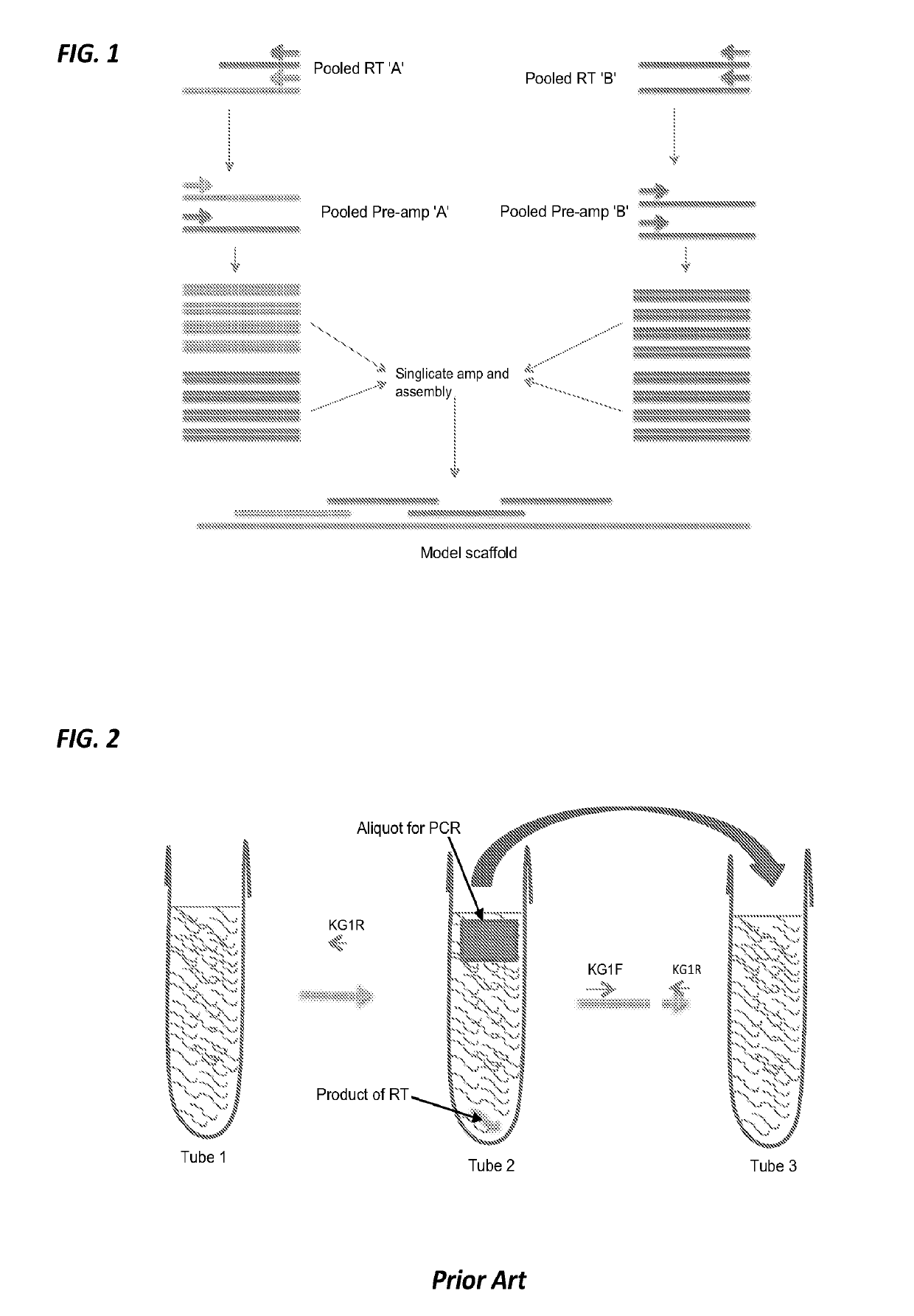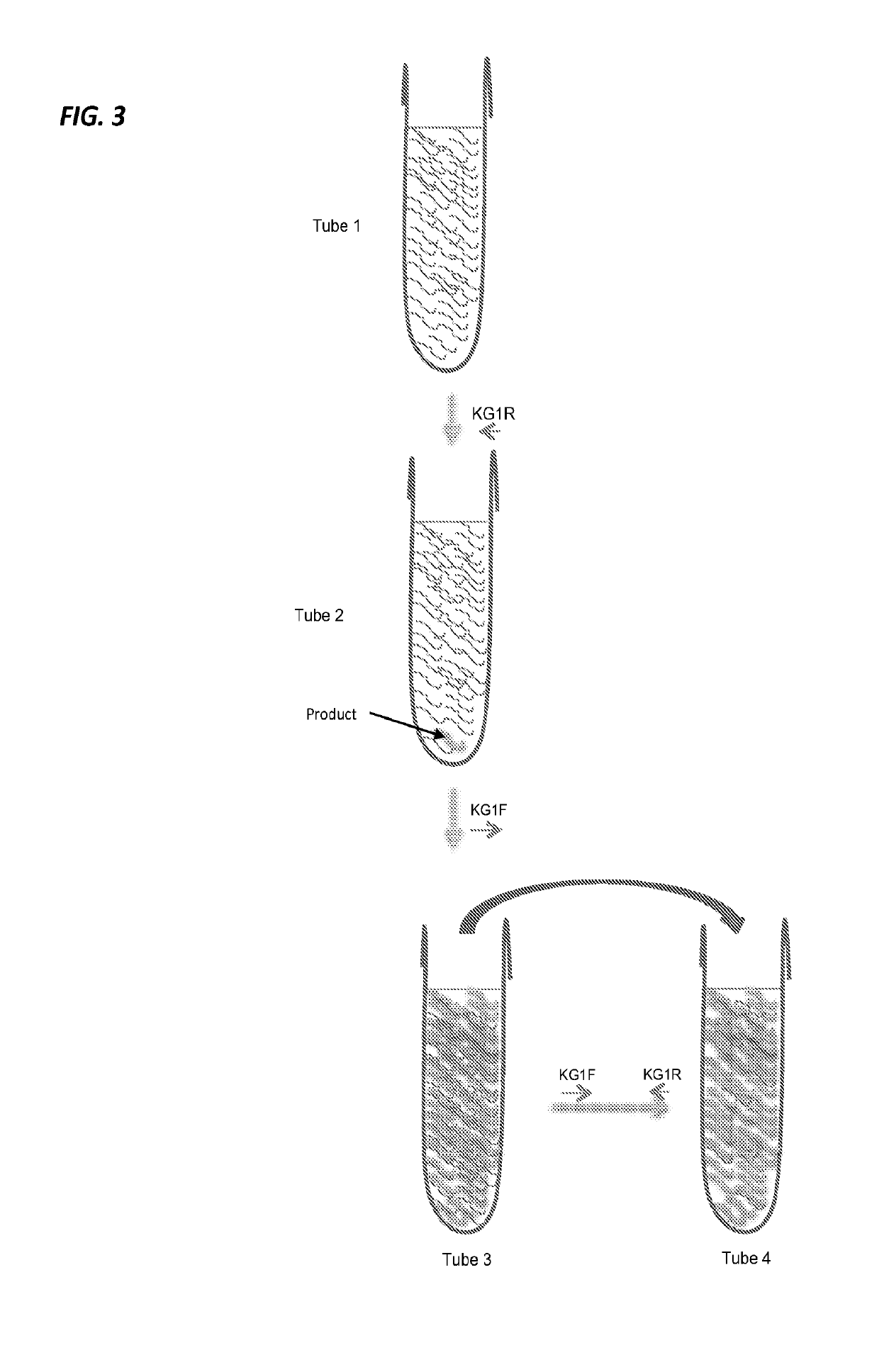Methods and systems for RNA or DNA detection and sequencing
a technology detection method, applied in the field of detection and sequencing of rna or dna, can solve the problems of low titer, prone to miss single rt-pcr assay, and issue related to sequence evolution
- Summary
- Abstract
- Description
- Claims
- Application Information
AI Technical Summary
Benefits of technology
Problems solved by technology
Method used
Image
Examples
example 1
rum Samples
[0034]Example 1 describes an example of a protocol for plasma / serum samples. The present invention is not limited to the details of Example 1. This example describes a procedure for working up a sample using 40 overlapping primer pairs designed to generate products of approximately 200 bp. This will provide 6000+ bp of sequence. Actual amount of sequence is a function of how much overlap designed into the primers. For FFPE samples or severely degraded liquid samples, 70-100 bp primer pairs may be designed. High quality proof-reading Taq is used. This protocol uses Promega Goscript and RNAsin plus for RT. Taq is Accustart.
[0035]Make up 4 forward primer pools (A, B, C, D) and 4 matching reverse primer pools (A, B, C, D). The following schematic may be used (for both forward group and reverse group):
Pool APool BPool CPool DPrimer #1234Primer #5678Primer #9101112Primer #13141516Primer #17181920Primer #21222324Primer #25262728Primer #29303132Primer #33343536Primer #37383940
[00...
example 2
of HIV Sequences from Degraded Archival Samples
[0042]Methods of the present invention for recovering viral RNA were used test 1970s HIV serum samples (degraded archival samples). Example 2 describes the recovery of eight near-full-length genomes from US serum samples from 1978-79—eight of the nine oldest HIV-1 group M genomes to date. Example 2 also describes recovery of the HIV-1 genome from the individual known as ‘Patient 0’ (Auerbach et al, 1984, Am J Med 76: 487-492) (showing there is neither biological nor historical evidence he was the primary case in the US or for subtype B as a whole).
[0043]HIV-1 Serological Screening of Serum Samples from San Francisco from 1978.
[0044]2231 samples collected from the cohort of gay and bisexual men in San Francisco in 1978 (Jaffe et al., 1985, Ann Intern Med 103: 210-214) were tested, and 83 WB-positives were detected (3.7% prevalence). Samples were first screened by GS HIV-1 / HIV-2 Plus O EIA (Bio-Rad Laboratories, Redmond Wash.) and reactiv...
example 3
ichment and Multiplex RT-PCR Viral Genetic Screening Assays
[0049]Example 3 describes the development of viral enrichment and multiplex RT-PCR viral genetic screening assays that are more sensitive than existing RT-PCR protocols for detection of viral RNA. The methods of the present invention could allow recovery of viral genomic information from challenging source material (e.g., specimens with low concentration of template viral RNA, samples containing no viable (culturable) virus, etc.). The methods of the present invention may be useful in conventional samples as well, e.g., for conventional samples in resource-limited settings where culturing of virus may be precluded but RT-PCR may be possible. Without wishing to limit the present invention to any theory or mechanism, it is believed that the methods of the present invention may allow for detection of viral RNA with very high sensitivity (e.g., up to 100% specificity after sequencing). Thus, this may allow for the use of the met...
PUM
| Property | Measurement | Unit |
|---|---|---|
| temperature | aaaaa | aaaaa |
| length | aaaaa | aaaaa |
| temperature | aaaaa | aaaaa |
Abstract
Description
Claims
Application Information
 Login to View More
Login to View More - R&D
- Intellectual Property
- Life Sciences
- Materials
- Tech Scout
- Unparalleled Data Quality
- Higher Quality Content
- 60% Fewer Hallucinations
Browse by: Latest US Patents, China's latest patents, Technical Efficacy Thesaurus, Application Domain, Technology Topic, Popular Technical Reports.
© 2025 PatSnap. All rights reserved.Legal|Privacy policy|Modern Slavery Act Transparency Statement|Sitemap|About US| Contact US: help@patsnap.com


